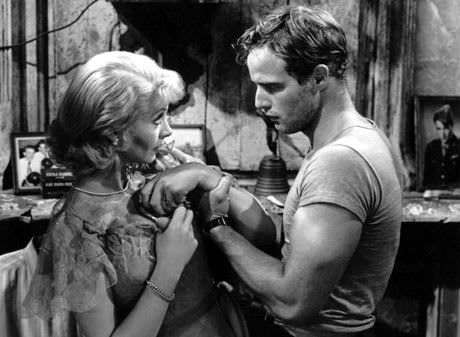As an exercise in research, I read some of the original reviews for A Streetcar Named Desire, both the 1951 film and the original Broadway play. Surprisingly, very little was made of Marlon Brando, then brand new to both Broadway and Hollywood. Brando's role as Stanley Kowalski, of course is now almost universally recognized as ground zero for the dramatic shift away from the classical Hollywood studio form of acting to the immersive method style. And yet the original Variety review is surprisingly understated in their praise, writing, "Marlon Brando, at times, captures strongly the brutality of the young Pole, but occasionally he performs unevenly in a portrayal marked by frequent garbling of his dialog." And in the original New York Times stage review, Brando barely gets a mention, "…the rest of the acting is also of very high quality indeed. Marlon Brando as the quick-tempered, scornful, violent mechanic." These statements, with today's eyes, read as hilariously gross understatements. Today it's impossible not to watch Kazan's film adaptation of Streetcar without centring on Brando; he's so dominant. And, honestly, its illustrious place in cinema notwithstanding, other than Brando, the film is plainly modest and stagey. Tennessee Williams' brooding, loquacious dialogue, read with singsong lyricism by Oscar-winner Vivien Leigh, always feels written and performed, never naturalistic, as intended by the method. "The method," of course, refers to the way in which an actor inhabits their character, working from the inside out to bring their emotions and experiences to the outside. Here it's not just Brando, but the performances of Kim Hunter and Karl Malden as well. But this was also a time when actors took themselves very seriously and much of the film feels heavy and weighted down by the lumbering devotion to Williams' words. All except for Brando, who appears to be transported from another dimension into this film. He's so good, so magnetic ― a dynamo. Stanley Kowalski here is less a creation of Williams then an expression of Brando, his personality commanding the screen. His outward appearance is a thing to behold, boldly showing off a kind of musculature we never saw in leading men, nimbly moving around the set with ease, eyes wandering around the space, his hands, fingers and feet constantly in motion. "Actor's business," it's called: little gestures to hypnotize us to Stanley Kowalski's magnetism. It was the ideal showcase for Brando; it wasn't his first role, but the one best suited to launch him. The creation of Stanley Kowalski was synonymous with the creation of Brando the star ― elusive and enigmatic. And so anyone trying to analyze Streetcar always goes back to Brando. As expected, the Warner Blu-Ray is beautifully packaged, with featurettes on the influence of Brando, as well as his treasured screen test, where he performs a scene from A Rebel Without a Cause! Other features have been cherry-picked from the DVD special edition, including Richard Schickel's documentary on Kazan, a commentary track featuring Schickel, Maldon, Rudy Behlmer and Jeff Young, and unmemorable minute fractions of outtakes unseen in the final film.
(Warner)A Streetcar Named Desire
Elia Kazan

BY Alan BacchusPublished May 8, 2012



